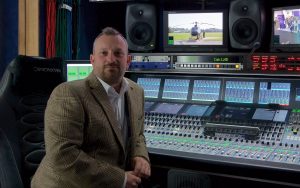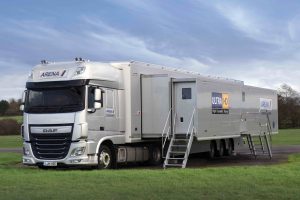IP from OBX to Z: An elegant evolution for Arena Television
Arena TV now has a fourth UHD HDR IP-based production truck, OBZ, which has already been used for Premier League football and will be covering the upcoming European Championship darts in Dortmund and World Series of Darts Finals in Vienna.
Its first IP truck, OBX, launched in 2016 and “OBZ is the fourth evolution of that design,” said Dafydd Rees, Arena Television’s deputy director of operations. The biggest change over the years has been the number of native IP products in the two trucks.

More efficient and elegant: Daf Rees in the audio area of Arena’s new OBZ
With OBX there were essentially only four native IP systems (the cameras, gateways, GV Node processing platform and Lawo audio monitoring units), whereas OBZ has about 16 native IP products including much more use of AES67 to transport the audio — while the vision mixer is now native IP.
In just two years they have many more options among a wider range of IP-enabled products from which to choose. This has made OBZ a much more elegant implementation — “now we can pick products that really do solve system problems,” Rees said.
However, it still isn’t all IP, and uses a number of gateway cards from Grass Valley and Axon. While the cards are all similar, they were chosen for different tasks. The Axon NUG and NGU 220 cards, for example, can handle down- or up-conversion, which are critical to its transmission paths, to create 50p and 50i HD deliverables from the UHD programme.
“That is a big change in the way we’ve done things in this truck, because previously the only way to do that was to go through a gateway to get to SDI and do the down-conversion in the SDI domain and then go back in to a gateway to re-encapsulate in IP.” Now it can do all this processing in IP, which has made this part of the system “much more efficient and much more elegant.”
Indeed, he feels the design of the truck overall is now much more elegant than it was with OBX, although that was partly because with the first IP truck everything had to be over-engineered to cope with every eventuality.
The other big change is how much more experience they have with IP. “Now we have a lot of staff who are very familiar with IP and can treat this very much as an everyday truck, whereas when we built OBX having to discover everything anew was challenging,” said Rees.
While they still needed their SDI knowledge, they had to cope with new types of problems with IP, and they spent a lot of time learning a lot more than they needed to for day-to-day operation, “but of course we didn’t know what was day-to-day operation at that time. So, in that two years our skillset has really moulded to fit the IP operation and the understanding that you need in the middle of a wet car park on a Saturday afternoon.”
The knowledge its staff have now gained, together with greater experience in the industry as a whole, has combined to make IP a realistic everyday prospect. “Certainly, over the last year, there’s been a real tipping point from doubts about whether IP can really work in this sort of environment to [a realisation that] IP is really the way to do things now.”
Replay is the biggest remaining area not to be IP. “Most of the gateway products in the truck are handling SDI conversion for replay devices,” he said.
Replay is the biggest remaining area not to be IP. “Most of the gateway products in the truck are handling SDI conversion for replay devices”
Other than that “we would love to see more IP processing. We still use baseband a lot for colour correction and synchronisation, and we’d love to see more of that happen natively.”
He would also like to see better (more flexible) audio handling on 2110 devices, “but really things are coming along at pace and there is no reason to think that you should hesitate in building an IP system. It works, is stable and operationally successful.”
The truck has 32 Grass Valley LDX 86N HDR cameras (delivering 15 stops of dynamic range), a Grass Valley K-Frame X native IP vision mixer, Cisco 9508 57.6Tbps non-blocking switch, 12 EVS ChannelMax XT3 replay servers, Calrec Apollo audio mixer with Dolby Atmos, Axon NUG, NGU and NIO IP processing, and GV Node and Densité IP infrastructure.
Lessons in IP
“The biggest thing we’ve learnt is that, for the staff, some training is necessary, but it’s certainly not onerous — and you should never underestimate people’s abilities to learn and to adapt to new technologies.” An existing broadcast engineer won’t find it a great leap to adapt to, said Rees.
When the move to IP started, there had been questions about whether it was best to train broadcast engineers in IP, or IT engineers in broadcasting, but he believes that broadcast knowledge is still key.
“The basic principles of moving pictures and sound around are still here. They are encapsulated in IP

Outstanding in its own field: OBZ is Arena Television’s latest IP-based UHD truck
rather than an SDI stream,” he said. “The only skill you need to add to that is a fairly narrow understanding of how the IP bit works, and that is already becoming a lot simpler with all the IP monitoring tools on the market.
“We’ve just installed the Lawo Smart Dash and that takes away the necessity to type command line instructions into the system, and it presents a number of parameters of the switch graphically.” That removes a lot of the complications from having to deal with IP and he believes this user friendliness will only improve.
Where next?
“We’re just scratching the surface of what you can do with IP. One of the reasons for choosing an IP system in the first place is the fact that it is so agile, that it’s agnostic and flexible,” said Rees. It means that as more high frame rate devices become available, for example, they will be able to connect them to the IP system without difficulty.
HDR is the next big thing, and OBZ is ready for it, supporting both PQ (ST2084) and HLG (ST2100). In terms of infrastructure he feels there will be increased decentralisation – not necessarily remote working, as they are slightly different things, but it will allow OBs “to move away from big pieces of kit and have different devices in different places, exactly where you need them, which simplifies the design even more; and dematerialisation, where you have kit that isn’t dedicated to a particular task but you can spin up to do different tasks as the demand is there.”
This means that the resources in a truck can be applied to a variety of jobs as needed, whether an extra M/E on the mixer or an extra replay channel. “That’s going to be the next exciting thing in the IP world,” said Rees.
Was moving to IP early a good investment, and how did it stack up against the SDI alternatives?
“A quad SDI system was an unsatisfactory answer to the design brief that we had for these trucks, which was ‘can you make a very large truck in UHD with the amount of I/O in UHD that you are used to in HD?’. It is very difficult to do in a quad SDI environment,” he explained. Even if Arena had built an SDI truck, its lifetime would be limited.
“By investing in IP from the off, and in OBX, where the technology was new — and comparably probably more expensive than an SDI truck — what we have achieved is a truck that will last for ten years because of its flexibility and that central core being agnostic. You’re maximising that investment, rather than building an SDI facility and in four or five years having to replace that.” With OBZ he believes IP has now reached a point where there is negligible additional cost over SDI.
“What we have achieved is a truck that will last for ten years because of its flexibility and the central core being agnostic”
When it did the research for OBX in the first place, 12G SDI was the third possibility, but they felt it would tie them in to “a very narrow protocol.” Indeed, he now believes that even where 12G is most appropriate (in small systems) “IP is now as valid in those systems as 12G is. With a growing portfolio of IP products versus 12G products, I think IP would still be the choice in that sort of system and 12G is just a temporary stopgap for particular situations.”
Arena’s next move will be to add the K-Frame to its other three IP trucks, to give them native IP mixing. The trucks currently use 2022-6 (for video with embedded audio), “because when we started building OBX that was the only choice; -6 still provides the flexibility we need and we don’t see a huge rush to have to change to a 2110 system, although we will, of course, because that’s the way the industry is going, so there will be a time when we have to switch these over.”
OBZ is TR-04 compliant (2022-6 with AES67) as there are occasions when the trucks are used together and need to use the same standards, but all the trucks will probably move to 2110 over the next year or so – all the equipment is already 2110 capable.
“In terms of operation, I don’t think there are great advantages in moving to 2110, currently.” However, it should improve the flexibility in handling audio essences, especially on receiving devices where they need to have essences of different widths, and flexibly manipulate those essences on a take-by-take basis.
“So it would be good to have more equipment natively handling multiple essences, but until that happens there is no benefit of us moving from -6 to 2110, but we’ll have to do it in time because it will become the industry standard,” Rees explained. “Other than that, the systems we have are very capable and good for a good few years.”
